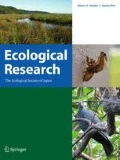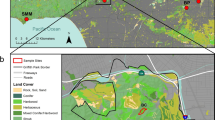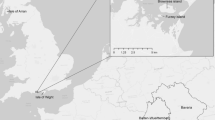Abstract
The Japanese squirrel (Sciurus lis) is endemic to Honshu and Shikoku, Japan. In suburban environments this squirrel has tended to disappear from smaller and/or more isolated woodlots. In this study, genetic structure was compared from 1999 to 2004 for two subpopulations, one in a continuous mountain forest of western Tokyo and the other in a neighbouring woodlot isolated by a busy road. By sequencing 434 bp of the mitochondrial DNA control region of all 69 squirrels living in the two habitats, nine haplotypes were detected. Both the number of haplotypes and their genetic diversity were lower in the isolated woodlot (5 and 0.62, respectively) than in the continuous forest (8 and 0.79). Yearly comparisons revealed that only two to three haplotypes occurred simultaneously in the isolated woodlot whereas four to six were always found in the continuous forest, although the number of resident squirrels per year did not differ between the two sites. Haplotype dynamics revealed that the female population in the isolated woodlot was in a monotypic state for over two years before immigration of females with different haplotypes occurred. In the isolated woodlot immigration was thus restricted and turnover was lower, particularly among females. Such demographic factors seem to maintain the lower genetic diversity of the isolated subpopulation.





Similar content being viewed by others
References
Aars J, Ims RA, Liu H-P, Mulvey M, Smith MH (1998) Bank voles in linear habitats show restricted gene flow as revealed by mitochondrial DNA (mtDNA). Mol Ecol 7:1383–1389
van Apeldoorn RC, Celada C, Nieuwenhuizen W (1994) Distribution and dynamics of the red squirrel (Sciurus vulgaris L.) in a landscape with fragmented habitat. Landsc Ecol 9:227–235
Barratt EM, Gurnell J, Malarky G, Deaville R, Bruford MW (1999) Genetic structure of fragmented populations of red squirrel (Sciurus vulgaris) in the UK. Mol Ecol 8:S55–S63
Bidlack AL, Cook JA (2001) Reduced genetic variation in insular northern flying squirrels (Glaucomys sabrinus) along the North Pacific Coast. Anim Conserv 4:283–290
Bidlack AL, Cook JA (2002) A nuclear perspective on endemism in northern flying squirrels (Glaucomys sabrinus) of the Alexander Archipelago, Alaska. Conserv Genet 3:247–259
Celada C, Bobliani G, Gariboldi A, Maracci A (1994) Occupancy of isolated woodlots by the red squirrel Sciurus vulgaris L. in Italy. Biol Conserv 69:177–183
David-Gray ZK, Gurnell J, Hunt DM (1998) DNA fingerprinting reveals high levels of genetic diversity within British populations of the introduced non-native grey squirrel (Sciurus carolinensis). J Zool 246:443–486
Delin AE, Andrén H (1999) Effects of habitat fragmentation on Eurasian red squirrel (Sciurus vulgaris) in a forest landscape. Landsc Ecol 14:67–72
Felsenstein J (1985) Confidence limits on phylogenies: an approach using the bootstrap. Evolution 39:783–791
Fitzgibbon CD (1993) The distribution of grey squirrel dreys in farm woodland: the influence of wood area, isolation and management. J Appl Ecol 30:736–742
Hale ML, Bevan R, Wolff K (2001a) New polymorphic microsatellite markers for the red squirrel (Sciurus vulgaris) and their applicability to the grey squirrel (S. carolinensis). Mol Ecol Notes 1:47–49
Hale ML, Lurz PWW, Shirley MD, Rushton S, Fuller RM, Wolff K (2001b) Impact of landscape management on the genetic structure of red squirrel populations. Science 293:2246–2248
Hale ML, Lurz PWW, Wolff K (2004) Patterns of genetic diversity in the squirrel (Sciurus vulgaris L.): footprints of biogeographic history and artificial introductions. Conserv Genet 5:167–179
Hirota T, Hirohata T, Mashima H, Satoh T, Obara Y (2004) Population structure of the large Japanese field mouse, Apodemus speciosus (Rodentia: Muridae), in suburban landscape, based on mitochondrial D-loop sequences. Mol Ecol 13:3275–3282
Kataoka T, Tamura N (2005) Effects of habitat fragmentation on the presence of Japanese squirrels, Sciurus lis, in suburban forests. Mammal Study 30:131–137
Kawamichi T (1997) Red list of Japanese mammals. Bun-ichi Sougou-Shuppan, Tokyo (in Japanese)
Keller LF, Arcese P, Smith JNM, Hochachka WM, Stearns SC (1994) Selection against inbred song sparrows during a natural population bottleneck. Nature 372:356–357
Lance SL, Maldonado JE, Bocetti CI, Pattee OH, Ballou JD, Fleischer RC (2003) Genetic variation in natural and translocated populations of the endangered fox squirrel (Sciurus niger cinereus). Conserv Genet 4:707–718
Lynch M, Gabriel W (1990) Mutation load and survival of small populations. Evolution 44:1725–1737
Madsen T, Stille B, Shine R (1996) Inbreeding depression in an isolated population of adders Vipera berus. Biol Conserv 75:113–118
Nei M, Roychoudhury AK (1974) Sampling variances of heterozygosity and genetic distance. Genetics 76:379–390
Nei M, Tajima F (1981) DNA polymorphism detectable by restriction endonucleases. Genetics 97:145–163
Oshida T, Masuda R (2000) Phylogeny and zoogeography of six squirrel species of the genus Sciurus (Mammalia, Rodentia), inferred from cytochrome b gene sequences. Zoolog Sci 17:405–409
Oshida T, Masuda R, Yoshida MC (1996) Phylogenetic relationships among Japanese species of the family Sciuridae (Mammalia, Rodentia), inferred from nucleotide sequences of mitochondrial 12S ribosomal RNA genes. Zoolog Sci 13:615–620
Reyes A, Gissi C, Pesole G, Catzeflis FM, Saccone C (2000) Where do rodents fit? Evidence from the complete mitochondrial genome of Sciurus vulgaris. Mol Biol Evol 17:979–983
Saccheri I, Kuussaari M, Kankare M, Vikman P, Fortelius W, Hanski I (1998) Inbreeding and extinction in a butterfly metapopulation. Nature 392:491–494
Saitou N, Nei M (1987) The neighbour joining method: a new method for reconstructing phylogenetic trees. Mol Biol Evol 4:406–425
Schulte-Hostedde AI, Gibbs HL, Millar JS (2001) Microgeographic genetic structure in the yellow-pine chipmunk (Tamias amoenus). Mol Ecol 10:1625–1631
Shibata K, Bandoh K, Yaekashiwa N, Matsuzaki T, Tamate HB (2003) A simple method for isolation of microsatellites from the Japanese squirrel, Sciurus lis, without constructing a genomic library. Mol Ecol Notes 3:657–658
Stacy JE, Jorde PE, Steen H, Ims RA, Purvis A, Jakobsen KS (1997) Lack of concordance between mtDNA gene flow and population density fluctuations in the bank vole. Mol Ecol 6:751–759
Swihart RK, Nupp TE (1998) Modeling population responses of North American tree squirrels to agriculturally induced fragmentation of forests. In: Steele MA, Merritt JF, Zegers DA (eds) Ecology and evolutionary biology of tree squirrels. Virginia Museum of Natural History, Special Publication No. 6, Virginia, pp. 1–19
Tajima F, Nei M (1984) Estimation of evolutionary distance between nucleotide sequences. Mol Biol Evol 1:269–285
Tamura N (1998) Forest type selection by the Japanese squirrel, Sciurus lis. Jpn J Ecol 48:123–127 (in Japanese)
Tamura N (2004) Effects of habitat mosaic on home range size of the Japanese squirrel, Sciurus lis. Mammal Study 29:9–14
Thompson JD, Higgins DG, Gibson TJ (1994) CLUSTALW: improving the sensitivity of progressive multiple sequence alignment through sequence weighting, positions-specific gap penalties and weight matrix choice. Nucleic Acids Res 22:4673–4680
Todd R (2000) Microsatellite loci in the Eurasian red squirrel, Sciurus vulgaris L. Mol Ecol 9:2155–2234
Trizio I, Crestanello B, Galbusera P, Wauters LA, Tosi G, Matthysen E, Hauffe HC (2005) Geographical distance and physical barriers shape the genetic structure of Eurasian red squirrels (Sciurus vulgaris) in the Italian Alps. Mol Ecol 14:469–481
Verbeylen G, Bruyn LD, Matthysen E (2003) Patch occupancy, population density and dynamics in a fragmented red squirrel Sciurus vulgaris population. Ecography 26:118–128
Wauters L, Casale P, Dhondt AA (1994a) Space use and dispersal of red squirrels in fragmented habitats. Oikos 69:140–146
Wauters LA, Hutchinson Y, Parkin DT, Dhondt AA (1994b) The effects of habitat fragmentation on demography and on the loss of genetic variation in the red squirrel. Proc R Soc Lond B 255:107–111
Wiegand P, Schropfer R (1997) DNA fingerprinting analysis of subpopulations of the red squirrel (Sciurus vulgaris L., 1758). J Zoolog Syst Evol Res 35:71–74
Wimmer B, Kappeler PM (2002) The effects of sexual selection and life history on the genetic structure of redfronted lemur, Eulemur fulvus, groups. Anim Behav 64:557–568
Acknowledgements
We thank the staff of the Bureau of Industrial and Labor Affairs, Agriculture, Forestry Section of Tokyo, for granting permission to capture squirrels. We also thank Tomomi Kataoka for providing tissue samples of S. vulgaris from Hokkaido, Japan. This study was funded by the Environmental Agency of Japan (Global Environment Research Program, F-1-4-2).
Author information
Authors and Affiliations
Corresponding author
About this article
Cite this article
Tamura, N., Hayashi, F. Five-year study of the genetic structure and demography of two subpopulations of the Japanese squirrel (Sciurus lis) in a continuous forest and an isolated woodlot. Ecol Res 22, 261–267 (2007). https://doi.org/10.1007/s11284-006-0019-7
Received:
Accepted:
Published:
Issue Date:
DOI: https://doi.org/10.1007/s11284-006-0019-7




